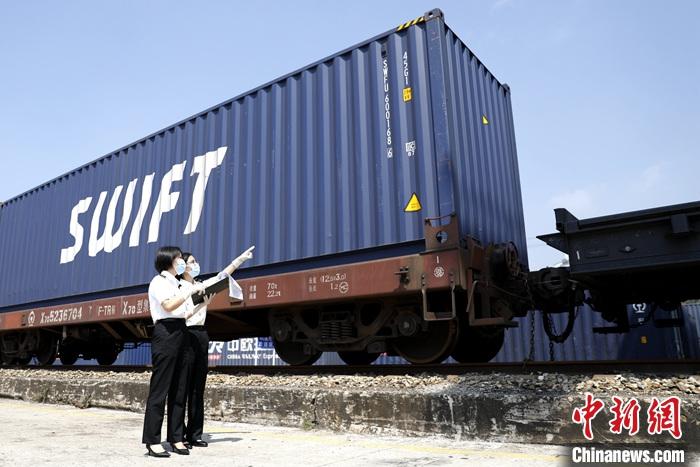China News Service, July 9th. According to the WeChat official account of "China Railway", from January to June, National Railways sent 1.845 billion tons of goods, an increase of 150 million tons or 8.9% year-on-year, and the average daily loading of 168,000 vehicles, year-on-year Increased 15,500 vehicles, an increase of 10.2%.
Data map: The goods pass through the checkpoint and are supervised by customs officers on site.
Photo by China News Agency reporter Li Siyuan
In the first half of this year, the railway department conscientiously implemented the central government’s deployment requirements for vigorously developing a green economy and adjusting the transportation structure, making full use of the existing line freight capacity released after the formation of the high-speed rail network to promote the continuous and steady growth of railway freight volume, effectively assisting economic and social development, and serving Build a new development pattern.
First, the transportation of key materials is effectively guaranteed.
Seize the favorable opportunity for strong coal transportation demand in the first half of the year, launch a special campaign to ensure the supply of electricity and coal, vigorously operate 10,000-ton trains, promote the strong growth of coal transportation, and ensure coal supply and market stability.
In the first half of the year, the national railway coal transportation volume completed 961 million tons, a year-on-year increase of 12.4%.
Among them, the coal transportation volume of Haoji, Tangbao, Wari, and Daqin railways increased by 163%, 54%, 43%, and 11.5% respectively year-on-year; the national railway coal and electric coal loaded daily averages of 76,000 vehicles and 49,000 vehicles, respectively Increased by 12.9% and 19.4%.
Intensify the transportation of ore from the port, strengthen the port connection, and actively promote the "revolution to iron", and the completed transportation volume is 206 million tons.
The transportation of agricultural materials was meticulously organized, green channels were opened, and transportation resources were prioritized. The transportation volume of grain and fertilizer reached 28.21 million tons and 25.16 million tons respectively, making positive contributions to rural revitalization.
Second, the level of container transportation has improved significantly.
Taking container transportation as the main direction of deepening the supply-side reform of transportation, giving full play to the advantages of high efficiency and convenience of containerization, and improving the level of container transportation loading.
Since the beginning of this year, we have purchased 100 new container reach cranes, vigorously promoted the "return to rail" and "bulk to assembly" (bulk transportation to container transportation) of suitable container sources, and researched and launched a batch of container through incremental projects to optimize the molten iron and railway transportation. Convergence of transportation methods, improve the quality of transportation services, and achieve a record high in container transportation loading.
In the first half of this year, 12.59 million TEUs of containers were delivered, a year-on-year increase of 29.5%.
Third, the China-Europe Express and the Western Land-Sea New Corridor Express are flying on both sides.
The role of the China-Europe railway line's strategic channel has become more prominent. We will continue to implement port expansion and efficiency projects, continue to strengthen cooperation with foreign railway enterprises and customs departments, make good use of the 95306 digital port, improve customs clearance efficiency, and shorten the delivery time limit.
In the first half of the year, China-Europe freight trains operated 7,377 trains and sent 707,000 TEUs, up 43% and 52% year-on-year, respectively, and the comprehensive heavy container rate reached 98%.
At present, the coverage of China-Europe Express trains has expanded to 168 cities in 23 European countries, and the cumulative number of trains has exceeded 40,000.
The new western land and sea corridors have grown rapidly, and have been efficiently connected with other modes of transportation, and the quality of operation has been further improved. In the first half of the year, 2,705 trains were opened and 269,000 TEUs of goods were sent, an increase of 112% and 319% respectively year-on-year.
In the next step, the railway sector will give full play to the green and low-carbon advantages of railways, and make greater contributions to building a green and low-carbon economic freight network system and reducing social logistics costs.

